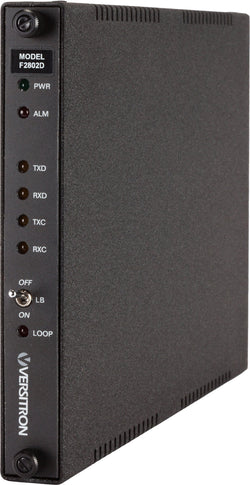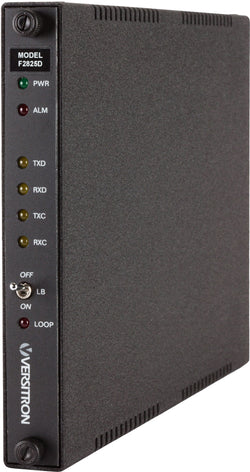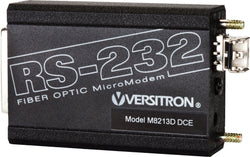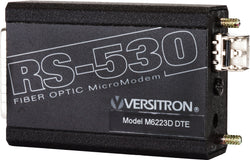Serial to Fiber Converters
Serial-to-fiber converters can convert serial data signals to Multimode or Singlemode fiber optic cable. VERSITRON manufactures serial to-fiber media converters that handle signals such as RS-232, RS-530, RS-422, MIL-188-114A (Balanced), and MIL-188-114A (Unbalanced). Our modems are available in two different formats:
- Micromodems are small compact form-factor
- FOM II modems which are circuit card devices
What are the Beneficial Features of Serial to Fiber Converters?
The main beneficial features of using VERSITRON’s industrial-grade serial-to-fiber converters include:
- Handle handshaking control signals associated with RS-232, RS-423, RS-530, and RS-422. Also, standards RS-449 or V.35 are supported.
- Our converters are widely used in military applications, as they support the conversion of MIL-STD-188-114A (balanced) and MIL-STD-188-114A (unbalanced) signals.
- Available in Single or Multimode fiber optic cable.
- Point-to-point link, redundant ring, or multidrop network environments supported.
- Compact in size, our converters possess a small footprint, presenting a notable advantage for applications constrained by limited space.
- These Micromodems feature multiple connections, and they can be easily connected to data terminals or other communication equipment.
- All our modems support synchronous, asynchronous, and continuously variable data transmission.
- Fully Transparent Operation with independent data, clock, and control lines.
- All our modems are equipped with LC connectors.
Applications of Serial to Fiber Optic Converters
Our serial to fiber optic converter and FOM II serial data to fiber converters are used in serial networks, long-distance networks, and high EMI environments. These are widely used for data control and communication in various applications such as the following:
- Traffic Monitoring/Transportation
- Manufacturing or Assembly Platforms, Industrial Automation
- Heavy Electrical Equipment
- Underwater data communication for submerged equipment
- Airports
- Healthcare
- Defense and Military Proprietary / Confidential Applications
Working Principle of Serial to Fiber Media Converters
Like any other networking device, the working principle of the serial-to-fiber media converter also depends on the topology into which it is integrated. Electrical-to-optical signal conversion and optical-to-electrical conversion are performed similarly across these devices.
The working principle of serial to fiber converter will differ as per the input, output, and transmission requirements of the network.
The following are two popular topologies, which are widely adopted by industrial networks across the globe. Gaining an understanding of these topologies will help you understand the workings of these devices as well.
- Ring Mode/Topology: Ring mode/topology in serial over fiber converters refers to a type of network architecture that allows multiple devices to be connected in a loop or ring configuration. In this configuration, data flows in one direction around the loop, and each device receives and retransmits the data to the next device in the loop. This topology is also known as a ring network. Ring topology is usually employed for long-distance transmissions. It supports up to 100km transmission. Ring topology is also suited for managed serial media converters.
- Pair Connection Mode/Topology: Pair Connection Mode/Topology refers to how devices connect in a network. In this mode, devices are connected in a point-to-point fashion, with each device being connected to only two other devices. This creates a topology that is similar to a chain or a linear structure, with devices arranged in a linear sequence. Although effective, this topology is best suited for short distances such as 20 km networks and so on. The inputs and outputs will vary as per the connections of the output/input signal-controlling unit and media converters. It is also commonly used in serial communication protocols, such as RS-232 or RS-485, where data is transmitted sequentially between two devices.
At VERSITRON, our innovative thinking and quality have helped us build a list of satisfied customers since our inception. Quality control is deeply integrated in our manufacturing and stringently followed through all phases of the production process. Our contribution to your project does not simply end after the installation, rather, we provide ongoing free and unlimited technical support for all fiber data and voice links listed on this page. Are you looking for serial over fiber converters for your applications? We look forward to helping you select the right product to meet your needs! All of our serial to fiber optic media converters are backed with our lifetime warranty.




